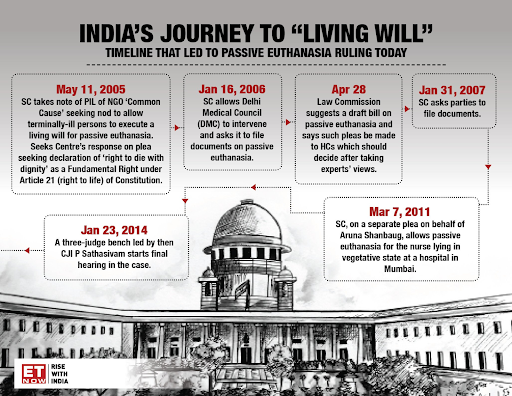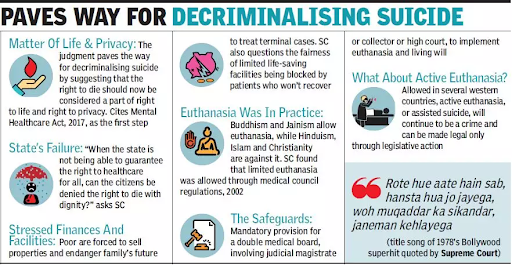Jean-Luc Godard
What’s in News:
- Jean-Luc Godard is recognised as the one of the most influential directors in the history of cinema.
- He is part of the French New Wave who revolutionized popular cinema in 1960.
- Godard chose to end his life through assisted suicide, a practice allowed under Swiss law.
The act of ending one’s’ own life
- Euthanasia is the act of deliberately ending a person’s life to relieve suffering.
- Assisted suicide: A doctor assists an individual in taking their own life if the person requests it.
- Euthanasia is defined as the administration of a lethal agent by another person to a patient for the purpose of relieving the patient’s intolerable and incurable suffering. Euthanasia is performed by physicians and has been further defined as “active” or “passive.” Active euthanasia refers to a physician deliberately acting in a way to end a patient’s life. Passive euthanasia pertains to withholding or withdrawing treatment necessary to maintain life.
- There are three types of active euthanasia.
- Voluntary euthanasia is one form of active euthanasia which is performed at the request of the patient. Involuntary euthanasia, also known as “mercy killing,” involves taking the life of a patient who has not requested for it, with the intent of relieving his pain and suffering.
- In nonvoluntary euthanasia, the process is carried out even though the patient is not in a position to give consent.
- Physician Assisted suicide, on the other hand, involves a physician providing medications or advice to enable the patient to end his or her own life.
Indian scenario

- In India, euthanasia is a crime. Section 309 of the Indian Penal Code (IPC) deals with the attempt to commit suicide and Section 306 of the IPC deals with abetment of suicide – both actions are punishable.
- Only those who are brain dead can be taken off life support with the help of family members. Likewise, the Supreme Court is also of the view that the right to life guaranteed by Article 21 of the constitution does not include the right to die.
- The court held that Article 21 is a provision guaranteeing protection of life and personal liberty and by no stretch of imagination can the extinction of life be read into it.
- The Supreme Court, in a landmark judgment, allowed passive euthanasia in the Aruna Shaunbag case,, a two-judge bench laid down a set of tough guidelines under which passive euthanasia can be legalized through a high-court monitored mechanism. The court further stated that parents, spouses, or close relatives of the patient can make such a plea to the high court.
- The Medical Treatment of Terminally Ill Patients (Protection of Patients and Medical Practitioners) Bill-2016
According to Indian traditions and other religions
- The intention to voluntarily kill oneself for selfish motives was condemned in Hinduism. It was in this context that the Dharmasutras vehemently prohibited suicide.
- Nevertheless, Hinduism venerated enlightened people who voluntarily decided their mode of death. (Pandavas eulogized “Mahaparasthana” or the great journey through their Himalayan sojourn). Such deaths by enlightened persons have never been equated with the popular notion of suicide in the Indian tradition.

International stands
- US: Euthanasia is illegal but physician-assisted suicide is legal.
- Netherlands and Belgium: Euthanasia and physician-assisted suicide have been legal
- Euthanasia is illegal in the UK.
Additional Information
- The doctrine of double effect- According to the principle of double effect, sometimes it is permissible to cause a harm as a side effect (or “double effect”) of bringing about a good result even though it would not be permissible to cause such a harm as a means to bringing about the same good end.
References:
- https://www.ncbi.nlm.nih.gov/pmc/articles/PMC3440914/
- https://www.thehindu.com/entertainment/movies/iconic-french-new-wave-director-jean-luc-godard-dead-at-91/article65886328.ece
Subscribe
Login
0 Comments
